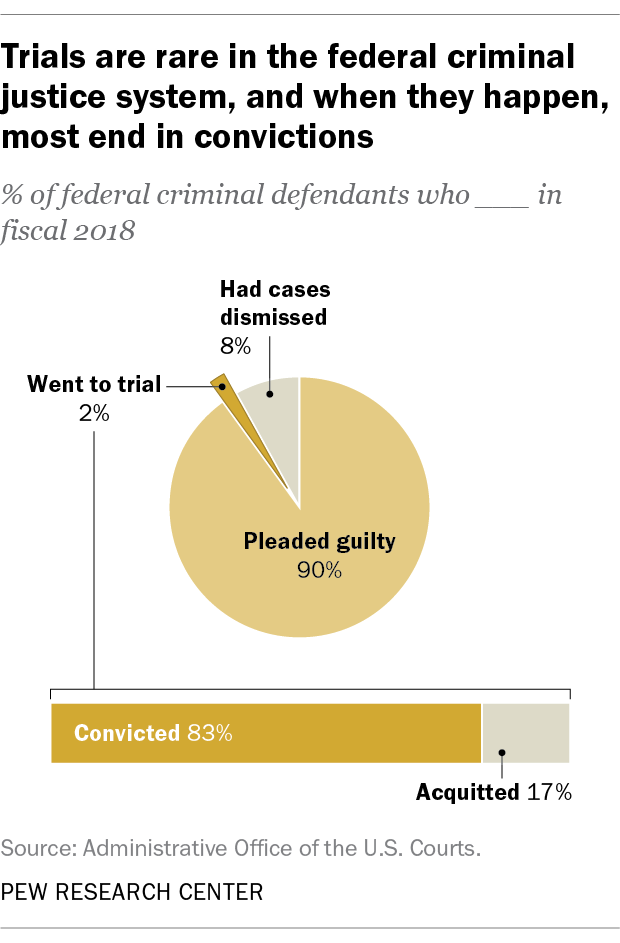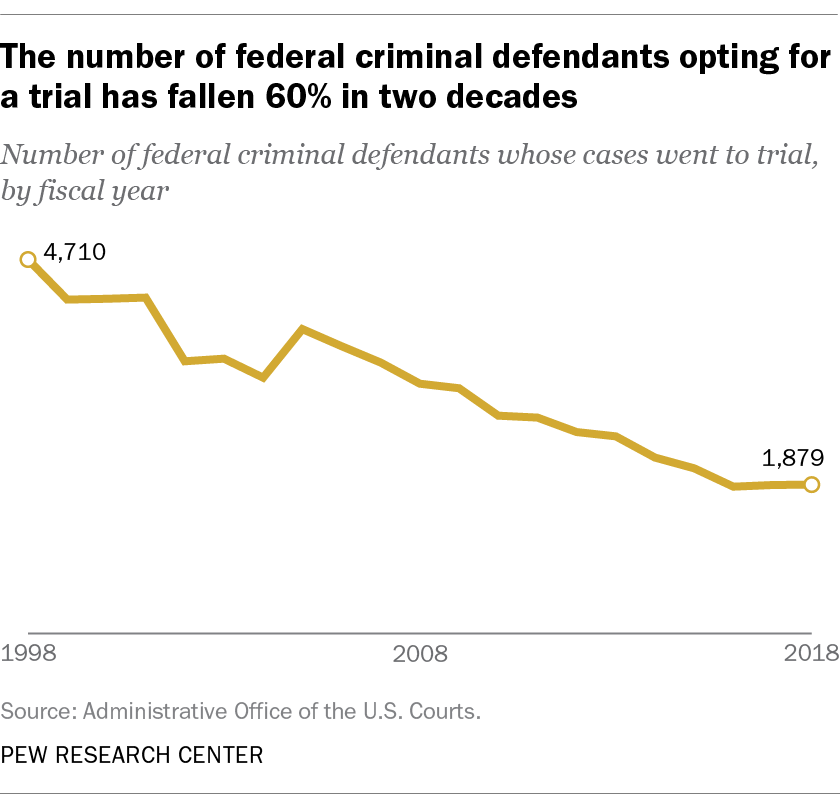Note: For the latest data on federal criminal defendants, read our June 2023 post.
Trials are rare in the federal criminal justice system – and acquittals are even rarer.

Nearly 80,000 people were defendants in federal criminal cases in fiscal 2018, but just 2% of them went to trial. The overwhelming majority (90%) pleaded guilty instead, while the remaining 8% had their cases dismissed, according to a Pew Research Center analysis of data collected by the federal judiciary.
Most defendants who did go to trial, meanwhile, were found guilty, either by a jury or judge. (Defendants can waive their right to a jury trial if they wish.)
Put another way, only 320 of 79,704 total federal defendants – fewer than 1% – went to trial and won their cases, at least in the form of an acquittal, according to the Administrative Office of the U.S. Courts. These statistics include all defendants charged in U.S. district courts with felonies and serious misdemeanors, as well as some defendants charged with petty offenses. They do not include federal defendants whose cases were handled by magistrate judges, or the much broader universe of defendants in state courts. Defendants who enter pleas of “no contest” are also excluded.
Trial rates are low regardless of the types of charges faced by federal defendants, but there are some variations across offense types. Fewer than 1% of federal defendants charged with immigration offenses (89 of 25,575) went to trial in fiscal 2018. The same was true of 2% of those charged with drug offenses (499 of 21,771) and 4% of those charged with property offenses (419 of 10,045). The trial rate was slightly higher for those charged with violent offenses (7%, or 192 of 2,879).
Among the small share and number of federal defendants who went to trial in fiscal 2018, those who opted for a bench trial – that is, one in which the verdict is handed down by a judge – fared better than those who opted for a jury trial. Around four-in-ten defendants who faced a bench trial (38%) were acquitted, compared with just 14% of those who faced a jury trial. Even so, bench trials are far less common than jury trials in the federal system: In fiscal 2018, only 12% of defendants who went to trial had their cases decided by a judge, while 88% had their cases decided by a jury.
Fewer trials, more guilty pleas

Trials have been relatively rare in the federal criminal justice system for decades, but they have become even less common over time. The share of defendants who went to trial fell from 7% in fiscal 1998 to 2% two decades later. In absolute terms, the number of defendants who went to trial plummeted from 4,710 in 1998 to 1,879 in 2018, even though the overall number of defendants in federal cases increased substantially during that span.
As trials have become rarer, guilty pleas have become more common. The share of federal criminal defendants who entered guilty pleas rose from 82% in 1998 to 90% two decades later. Guilty pleas rose in absolute numbers, too, from 55,913 in 1998 to 71,550 in 2018.
Not surprisingly, the decline in trials and rise in guilty pleas has corresponded with a decline in the number of Americans being called to serve on federal juries.
Experts have offered a range of explanations for the long decline in criminal trials. Among the most common is what critics refer to as the “trial penalty”: Individuals who choose to exercise their constitutional right to trial can face much higher sentences if they invoke the right to trial and lose, according to a 2018 report by the National Association of Criminal Defense Lawyers.
How state courts compare
Statistics about trial rates in state courts are harder to come by because each state runs its own court system and no standardized record-keeping system covers all states. But trial rates in criminal cases tend to be very low in the states for which data is available, according to a database maintained by the National Center for State Courts, an independent research organization focused on the state judiciary.
In 2017 – the year with the most recent data – jury trials accounted for fewer than 3% of criminal dispositions in 22 jurisdictions with available data, including Texas (0.86%), Pennsylvania (1.11%), California (1.25%), Ohio (1.27%), Florida (1.53%), North Carolina (1.66%), Michigan (2.12%) and New York (2.91%).
“If anything,” a 2017 law journal article said, “there is even less likelihood of a case proceeding to trial in state court than in federal court.”
This analysis measures trial rates in the federal criminal justice system by examining the annual number of defendants whose cases go to trial and result in either conviction or acquittal, based on data from the Administrative Office of the U.S. Courts. The Administrative Office publishes several other measures of trial frequency, including the annual number of criminal trials completed and the annual number of criminal trials resulting in verdicts. While these statistics differ in some ways, all show a broad decline in the frequency of federal criminal trials over the past two decades.
